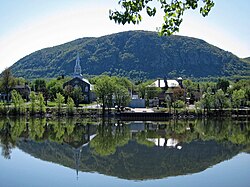Top Qs
Timeline
Chat
Perspective
Mont-Saint-Hilaire
City in Quebec, Canada From Wikipedia, the free encyclopedia
Remove ads
Mont-Saint-Hilaire (French pronunciation: [mɔ̃ sɛ̃t‿ilɛʁ]) is a suburb of Montreal on the South Shore of southeastern Quebec, Canada, on the Richelieu River in the Regional County Municipality of La Vallée-du-Richelieu. The population as of the Canada 2021 Census was 18,859. The city is named after the Mont Saint-Hilaire.
Remove ads
A significant deposit of the semi-precious mineral sodalite is located near Mont-Saint-Hilaire.
Remove ads
History

Jean-Baptiste Hertel de Rouville was granted the seignory of the region in 1694.[5] By 1745 a mountain village had been formed with the first chapel being built in 1798 near the Richelieu River. Nearly twenty years later, in 1822, a ferry operating between Beloeil and Mont-Saint-Hilaire came into service. A bridge, enabling Beloeil and St. Hilaire to be connected by rail, was built in 1848 by the St. Lawrence and Atlantic Railway.
The Campbell family, which owned the mountain after the Rouvilles, sold the mountain to an English officer, Brigadier-General Andrew Gault, who owned it for 45 years. Gault then bequeathed the mountain to McGill University before his death in 1958.
Remove ads
Demographics
In the 2021 Census of Population conducted by Statistics Canada, Mont-Saint-Hilaire had a population of 18,859 living in 7,766 of its 7,917 total private dwellings, a change of 1.5% from its 2016 population of 18,585. With a land area of 44.08 km2 (17.02 sq mi), it had a population density of 427.8/km2 (1,108.1/sq mi) in 2021.[6]
Remove ads
Attractions

- The Gault Nature Reserve on Mont Saint-Hilaire includes over a thousand hectares of primeval forest. Owned by McGill University, the nature reserve is used for research and recreation.
- The Museum of Fine Arts (Le Musée des beaux-arts) of Mont-Saint-Hilaire is the major art museum on the south shore of the Saint Lawrence River. It was founded in 1993 to promote the work of regional artists Jordi Bonet, Paul-Émile Borduas and Ozias Leduc.[9] Exhibitions also feature art from the area, such as Saint-Hilaire et les Automatistes in 1997, and Leduc, Borduas et le paysage de Saint-Hilaire in 2008, as well as other Quebec artists such as Jean-Paul Lemieux and Nancy Petry.[10]
- Art Station
- Art centre Ozias Leduc
- Manoir Rouville-Campbell
- Saint-Hilaire church
Infrastructure
Mont-Saint-Hilaire is served by the Mont-Saint-Hilaire commuter rail station on the Réseau de transport métropolitain's (RTM) Mont-Saint-Hilaire line. Local bus service is provided by the RTM's Vallée du Richelieu sector.[citation needed]
In 1864, Canada's worst rail disaster occurred here when a passenger train passed a red signal and fell off an open swing bridge into the Richelieu River, killing around 99 people.[citation needed]
Remove ads
Education

The town is home to 4 primary schools: Au-fil-de-l'eau (659 pupils), de l'Aquarelle (354 pupils) and de la Pommeraie (383 pupils) and Paul-Émile-Borduas. There are also 2 secondary schools, including Ozias-Leduc, with 1,480 students[11] and Collège Saint-Hilaire, a private high school that receives students from the region.[12]
The South Shore Protestant Regional School Board previously served the municipality.[13]
Remove ads
Notable people
- Louis Domingue, ice hockey player most recently for the Pittsburgh Penguins of the National Hockey League
- Laurent Duvernay-Tardif, football player most recently for the New York Jets of the National Football League

Photo gallery
- Reception arch in front of the town hall of Saint-Hilaire
- View of Mont Saint-Hilaire, the intersection of boulevard Honorius-Charbonneau and rue du Centre-Civique
- Mont Saint-Hilaire (Quebec) seen from the train station parking lot in winter 2022.
- Wayside cross in Mont-Saint-Hilaire (corner of Chemin des Patriotes and rue de Lisbonne)
See also
References
External links
Wikiwand - on
Seamless Wikipedia browsing. On steroids.
Remove ads







